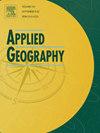利用智能卡数据发现老年人和年轻人的旅行群体
IF 4
2区 地球科学
Q1 GEOGRAPHY
引用次数: 0
摘要
交通网络中的个人移动创造了活动空间,形成了旅行社区。然而,很少有研究考察不同地域公交出行的空间结构和相关因素,这可能会忽略这些群体的基本出行模式和特征。以中国北京一个月的公交智能卡数据为例,我们首先建立了老年人和年轻人的空间互动网络,并对网络的各种指标进行了分析。然后,我们利用莱顿算法检测出行社区,并基于泊松回归模型进一步研究不同社区间公交车流量的决定因素。研究结果表明,与年轻人相比,老年人的高峰间隔更短、活动空间更本地化、网络连通性更低、交互强度更弱,这表明老年人在公交出行中的流动性有限。研究强调,无论在哪个地理区域,出行时间长短和土地使用组合对这两个群体来说都是重要的预测因素,而且在不同地区的社区中,影响公交出行的因素也存在差异。这项研究的结果可以更好地描述老年人和年轻人的流动模式、出行网络、活动结构以及影响公交出行流量的决定因素,从而为城市交通发展提供细致有效的战略支持。本文章由计算机程序翻译,如有差异,请以英文原文为准。
Uncovering travel communities among older and younger adults using smart card data
Individual movements within transport networks create activity spaces that shape travel communities. However, few studies have examined the spatial structures within bus travel and the associated factors across different geographic areas, which may overlook the underlying travel patterns and characteristics within these communities. Taking one-month bus smart card data in Beijing, China as a case study, we first build spatial interaction networks for older and younger adults, and conduct analysis on various network measures. Then we detect travel communities using Leiden algorithm and further investigate the determinants for bus flows across different communities based on Poisson regression models. The findings indicate that older adults have a shorter peak interval, more localized activity spaces, lower network connectivity, and weaker interaction strength, suggesting limited mobility in bus travel compared to younger adults. The study highlights that travel duration and land use mix are important predictors for both groups regardless of geographic areas, and there are also differences in the factors influencing bus travel across various regional communities. The results of this study could better portray the mobility patterns, travel networks, activity structures, and determinants impacting bus travel flows among older and younger adults, thereby providing nuanced and efficient strategic support for urban transportation development.
求助全文
通过发布文献求助,成功后即可免费获取论文全文。
去求助
来源期刊

Applied Geography
GEOGRAPHY-
CiteScore
8.00
自引率
2.00%
发文量
134
期刊介绍:
Applied Geography is a journal devoted to the publication of research which utilizes geographic approaches (human, physical, nature-society and GIScience) to resolve human problems that have a spatial dimension. These problems may be related to the assessment, management and allocation of the world physical and/or human resources. The underlying rationale of the journal is that only through a clear understanding of the relevant societal, physical, and coupled natural-humans systems can we resolve such problems. Papers are invited on any theme involving the application of geographical theory and methodology in the resolution of human problems.
 求助内容:
求助内容: 应助结果提醒方式:
应助结果提醒方式:


